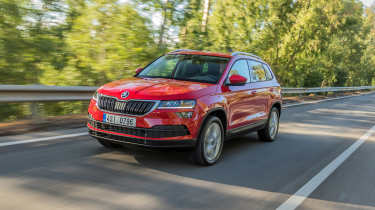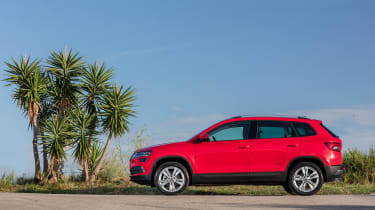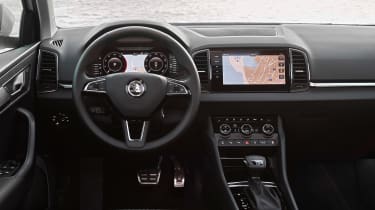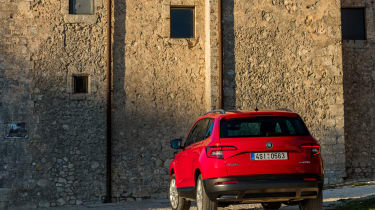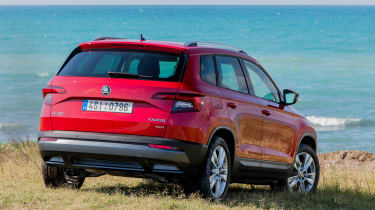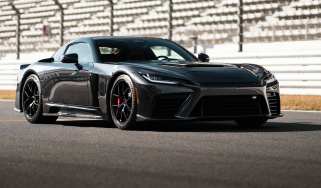New Skoda Karoq 2017 review – can it charm like the Yeti?
Capable, refined and practical crossover that’s decent to drive and attractively priced, but lacks the charm and character of the old Yeti
Here at evo we have a bit of a soft spot for the square-rigged Skoda Yeti. Value for money family cars that feature jacked-up suspension and Tonka toy styling aren’t our usual cup of tea, but the Czech machine’s fun-loving driving dynamics made it hard not to fall for. Equipped with the eager 158bhp 1.8-litre TSI petrol, the Yeti had the grip and go to humble the odd hot hatchback.
However, in the eight years since the Yeti first hit showrooms the market for compact SUVs and crossovers has exploded, with manufacturers falling over themselves to get a slice of the lucrative action. As a result, Skoda has retired the Yeti – and its distinctive name – in favour of the all-new Karoq, which is pitched against capable rivals such as the mechanically similar SEAT Ateca and Peugeot 3008. So, is the new car a welcome improvement or will abandoning the Yeti’s winning formula prove to be an abominable mistake?
> Click here for our review of the Seat Ateca
Certainly the Karoq is lacking the Yeti’s bold visuals. It’s smart enough, with crisp lines and neat detailing, but it’s just a little bland. There are some bold colour choices that help it stand out from the crowd, but at a glance it could easily be mistaken for its close cousin the Ateca. Still, all the standard SUV cues are present and correct, including the raised ride height and chunky body cladding.
Inside, the Karoq delivers a step change in quality for Skoda, with soft touch plastics, piano black trim and a glossy looking infotainment screen giving the cabin a really upmarket feel – it gives the products of parent firm VW a run for their money in this respect. Other highlights include the optional TFT dials, which get Skoda specific graphics but are essentially lifted straight out of a VW Golf. The same goes for the intuitive and slick-looking touchscreen infotainment systems.
More reviews
Group tests
- Lotus Emira Turbo SE v Alpine A110 GTS – two of the last surviving mid-engined sports cars
- Alpine A290 v Alpine A110 – how much DNA do they really share?
- Ariel Atom 4R v Caterham Seven ‘evo25’: power-to-weight heroes go head-to-head
- Ariel Atom 4 v Caterham Seven 310R v Lotus Elise Cup 250
- £200,000 supercar shoot-out: AMG v Aston Martin v Maserati v McLaren
- Audi Quattro, RS2 and RS3: five-cylinder icons head-to-head
- Who makes the best GT car? Aston Martin v Bentley v Maserati
- Caterham Super Seven 600 v Super Seven 2000
- Corvette Stingray v Porsche Cayman GTS v Audi R8 RWD
- Great Ferrari hypercars driven: 288 GTO, F40, F50 and Enzo head-to-head
In-depth reviews
- Abarth 600e 2025 review – Italy gives the Alpine A290 something to worry about
- Alpine A110 review – the sports car Lotus should be building
- Aston Martin Vantage 2025 review – a thrilling Mercedes-AMG GT and 911 Turbo S alternative
- Audi R8 (2015 - 2024) review – the ultimate soft-focus supercar
- BMW iX 2025 review – the ugly duckling still stomps the Tesla Model X
Long term tests
- Abarth 695C Turismo Fast Fleet test – living with the charming Italian hatch
- Alfa Romeo Giulia Veloce long term test – can Italy beat Germany?
- Alpina B10: Alpina B10: end of term report
- Aston Martin Vantage (2006) Fast Fleet test – living with a £30k V8 Aston
- Caterham Seven evo25 Fast Fleet test – living with a track car for the road
- Caterham Seven evo Edition revealed – bespoke 420R joins the Fast Fleet
- Cupra Leon 300 Fast Fleet test – living with Spain's 300bhp hot hatch
- Cupra Ateca VZN Fast Fleet test – four months with Cupra's hot crossover
- Cupra Leon Estate 310 4Drive Fast Fleet test – living with the 306bhp hot estate
- Ford Mustang GT
Review
- New Bentley Batur 2023 review – can it possibly be worth £1.65m?
- 2023 Chevrolet Corvette C8 Z06 review – the American 911 GT3?
- BBR Supercharged Mazda MX-5 (ND) 2023 review – tuned 250bhp roadster driven
- MG4 Trophy 2023 review
Reviews
- Abarth 695 75 Anniversario edition 2024 review – a fitting send-off for Abarth’s hot supermini?
- Abarth 500e 2023 review
- AC Cobra 378 Superblower MkIV 2021 review – another V8 Cobra, but with a GM heart this time
- Acura Integra Type S 2024 review – a Honda Civic Type R with added restraint
- Alfa Romeo Giulia review – get one while you still can
- Alfa Romeo 33 Stradale 2025 review – a rare Italian jewel beyond compare
- Alfa Romeo SZ: history, review and specs of an icon
Still, Skoda hasn’t forgotten its sensible roots, and the interior is packed with thoughtful touches that suggest this is a car that’s been designed by those that understand a family’s needs – highlights include the large boot and a sliding and folding rear bench.
> Click here for our review of the Peugeot 3008
There’s a wide range of adjustment for the seat and wheel, with only the bus-like rake of the latter undermining an otherwise comfortable driving position.
Technical highlights.
If you’re familiar with the SEAT Ateca, then the Skoda won’t hold any surprises. It’s based on exactly the same scalable MQB platform that also underpins models as diverse as the VW Golf and seven-seat Skoda Kodiaq SUV. However, while these models get lengthened or shortened structures to suit, the Karoq takes the Ateca’s platform over wholesale. In fact, apart from the slightly different visual treatments, the only other major change is to the springs and dampers, which have been tweaked for a smoother ride.
Still, there are some technical additions that it’s worth mentioning. Like all MQB cars, the Karoq’s structure is built with elements of high strength steel and aluminium, the combination of which delivers a strong and reasonably light structure – the entry-level 1-litre TSI tips the scales at just 1265kg.
> Click here for our review of the mk7 Volkswagen Golf
All front-wheel drive versions feature a traditional suspension layout of struts at the front and a torsion beam axle at the rear, while four-wheel drive models get a more sophisticated independent four-link set-up. Adaptive dampers are expected to be available as an option from 2018.
Speaking of four-wheel drive, the total traction transmission is carried over from the VW parts bin and features the latest generation Haldex-controlled differential. On the road it essentially runs in two-wheel drive, sending torque to the rear axle when slip is detected – although unlike previous generations of the system it reacts much faster than before. There’s also an off-road function that primes the traction control and braking systems for slippery conditions, plus it triggers the hill descent control. If you are planning on hitting the rough stuff, then the optional off-road package adds underbody protection for the engine and brake lines.
A six-speed manual gearbox is standard on most models, while a seven-speed DSG twin-clutch transmission is available as an option on all models apart from the 187bhp 2-litre TDI, which gets the self-shifter as standard.
Engine, transmission and 0-62mph time
As you’d expect, the Karoq engine line-up is essentially an array of tried and tested VW group units. Entry-level models get the 113bhp turbocharged 1-litre three-cylinder, which delivers reasonably lively performance that feels quicker than its claimed 0-62mph sprint of 10.3sec. This is largely down to the triple’s smoothness and eagerness to rev, while the slick and precise six-speed makes it easy to access what performance there is. Of course, load the Karoq up with more than a couple of adults and the small engine will start to struggle, particularly up steeper inclines and when overtaking.
A better bet is the new 148bhp 1.5-litre TSI that recently debuted in the VW Golf. If features Active Cylinder Deactivation (ACT), which effectively allows the Karoq to run on two cylinders during light throttle applications, helping to cut fuel use. Work the unit harder and you’ll discover brisk performance, with the 0-62mph sprint dispatched in a warm hatch-rivalling 8.1sec (8.3sec if you opt for the DSG version). Like the 1-litre, the larger four-cylinder powerplant is reasonably refined and has a decent appetite for hard work. In terms of outright performance, it’s more or less on a par with the 148bhp 2-litre TDI. This engine is muted enough for a diesel, but it doesn’t rev with the same enthusiasm as the petrol. It counters this with a healthy slug of torque – 251lb ft at 1750rpm compares well with 184lb ft at 1500 rpm for the 1.5 TSI.
Until the much mooted Karoq vRS model arrives, the 187bhp 2-litre TDI sits at the top of the performance tree. It’s not due in UK showrooms until later in 2018, but when it does arrive it will be comfortably the quickest option. It’s DSG and four-wheel drive only, but still manages to sprint from standstill to 62mph in 7.8sec. Like the lower powered diesel it’s not an engine that sounds particularly sweet or relishes revs, but there’s no doubting it’s an effective performer. That’s largely down to the combination of quick and smooth shifting gearbox and generous torque peak of 295lb ft at just 1750rpm.
What’s it like to drive?
The facetious answer to this question would be: ‘well, if you’ve driven a SEAT Ateca then you’ll know’. However, that would be to dismiss some of the good work Skoda’s engineers have put into the suspension.
Essentially, Skoda has tried to give the Karoq a more refined and comfortable feel than the Ateca, which is the ‘sporty’ choice in the VW group firmament. You certainly feel the fruits of the chassis engineer’s labours from the moment you set off. Where the SEAT suffers from a slight brittleness in its ride quality, the Skoda lopes along with a pleasing mix of suppleness and control. Even the really nasty potholes on our Sicilian test route failed to upset the car’s composure: where we expected a gut wrenching crash the suspension simply checked any waywardness.
> Click here for our review of the Nissan Qashqai
This focus on comfort doesn’t come at the expense of agility, and the Karoq can be hustled effectively through a series of corners. The electrically assisted steering is direct and naturally weighted, while there’s decent grip at the front end. The combination of high ride height, modest rubber and, in the diesel models, hefty engines means the nose will wash wide when pushed, but you do have to provoke this behaviour with aggressive inputs.
Amusingly, the four-wheel drive versions can be provoked into brief bouts of power oversteer out of tight first or second gear bends – although this behaviour requires the stability control to be in its Sport setting (typically, you can’t turn the safety nets off completely). You can also alter the weight of the steering and response of the throttle using the driver modes set-up (Eco, Normal, Sport, Individual and Snow), but on a car like this it’s best just to leave it in Normal.
For most of the time, the Karoq is a calm, capable and refined choice for daily duties.
Price and rivals
The entry-level 1.0 TSI SE weighs in at £20,875, while at the other end of the spectrum is the 2.0 TDI 4X4 DSG Edition, which costs an eye-watering £31,690. For most buyers the 1.5 TSI SE L will deliver the best blend of performance and kit, and at £24,515 it represents decent value, too. However, it’s worth noting that if you want four-wheel drive, then you’re currently limited to the 2.0 TDI models.
Facing off against the Karoq are models such as the SEAT Ateca, Peugeot 3008 and Nissan Qashqai. While it’s not quite as sharp to drive as the SEAT, it’s close enough as to make little or no difference in the context of the likely daily duties of these cars. It’s also got the Peugeot licked for comfort and refinement and feels even more practical and robustly built than the Nissan. If you’re in the market for a compact crossover, then you can do a lot worse than the Karoq. Lets keep our fingers crossed that the vRS version sees the light of day.
